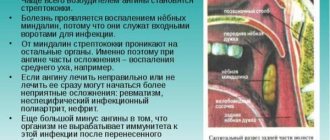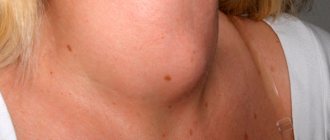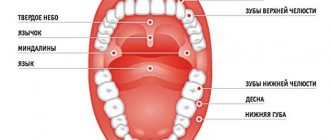Anatomical structure of the throat and pharynx
The throat contains a large number of nerves, important blood vessels and muscles. There are two parts of the throat - the pharynx and larynx. Their trachea continues. The functions between the parts of the throat are divided as follows:
The pharynx moves food into the digestive system and air into the respiratory system. The vocal cords work thanks to the larynx.
Photo of vocal cords during laryngoscopy
Pharynx
Another name for the pharynx is pharynx. It starts at the back of the mouth and continues down the neck. The shape of the pharynx is an inverted cone.
The wider part is located at the base of the skull for strength. The narrow lower part connects to the larynx. The outer part of the pharynx continues with the outer part of the mouth - it has quite a lot of glands that produce mucus and help moisten the throat during speech or eating.
The pharynx has three parts - the nasopharynx, oropharynx and swallowing section.
Nasopharynx
The uppermost part of the pharynx. She has a soft palate, which limits her and, when swallowing, protects her nose from food getting into it. On the upper wall of the nasopharynx there are adenoids - a collection of tissue on the back wall of the organ. The nasopharynx is connected to the throat and middle ear by a special passage - the Eustachian tube. The nasopharynx is not as mobile as the oropharynx.
Oropharynx
Middle part of the pharynx. Located at the back of the oral cavity. The main thing this organ is responsible for is the delivery of air to the respiratory organs. Human speech is possible due to contractions of the muscles of the mouth. The tongue is also located in the oral cavity, which facilitates the movement of food into the digestive system. The most important organs of the oropharynx are the tonsils; they are the ones most often involved in various throat diseases.
Swallowing department
The lowest section of the pharynx with a self-explanatory name. It has a complex of nerve plexuses that help maintain synchronous functioning of the pharynx. Thanks to this, air enters the lungs, and food enters the esophagus, and everything happens at the same time.
Larynx
The larynx is located in the body as follows:
Opposite the cervical vertebrae (4-6 vertebrae). At the back is the immediate laryngeal part of the pharynx. In front - the larynx is formed thanks to a group of hyoid muscles. Above is the hyoid bone. Laterally, the larynx is adjacent with its lateral parts to the thyroid gland.
The larynx has a skeleton. The skeleton has unpaired and paired cartilages. Cartilage is connected by joints, ligaments and muscles.
Unpaired: cricoid, epiglottis, thyroid.
Paired: horn-shaped, aryten-shaped, wedge-shaped.
The muscles of the larynx, in turn, are also divided into three groups:
Four muscles narrow the glottis: the thyroarytenoid, cricoarytenoid, oblique arytenoid and transverse muscles. Only one muscle widens the glottis - the posterior cricoarytenoid. She is a steam room. Two muscles tense the vocal cords: the vocal cord and the cricothyroid.
The larynx has an entrance.
Behind this entrance are the arytenoid cartilages. They consist of horn-shaped tubercles that are located on the side of the mucous membrane. In front is the epiglottis. On the sides there are aryepiglottic folds. They consist of wedge-shaped tubercles.
The laryngeal cavity is divided into three parts:
The vestibule stretches from the vestibular folds to the epiglottis, the folds are formed by the mucous membrane, and between these folds there is the vestibular fissure. The interventricular section is the narrowest. Stretches from the lower vocal cords to the upper ligaments of the vestibule. Its narrowest part is called the glottis, and it is created by intercartilaginous and membranous tissues. Subvocal area. Based on the name, it is clear that it is located below the glottis. The trachea expands and begins.
The larynx has three membranes:
The mucous membrane, unlike the vocal cords (they are made of squamous non-keratinizing epithelium), consists of multinucleated prismatic epithelium. Fibrous-cartilaginous membrane - consists of elastic and hyaline cartilages, which are surrounded by fibrous connective tissue, and provides this entire structure with the framework of the larynx. Connective tissue is the connecting part of the larynx and other formations of the neck.
The larynx is responsible for three functions:
Protective - the mucous membrane has ciliated epithelium, and it contains many glands. And if the food gets past, then the nerve endings carry out a reflex - a cough, which removes the food back from the larynx into the mouth. Respiratory - related to the previous function. The glottis can contract and expand, thereby directing air flow. Voice-forming - speech, voice. The characteristics of the voice depend on the individual anatomical structure. and the condition of the vocal cords.
The picture shows the structure of the larynx
Human anatomy: structure of the throat
In anatomical terminology, the word “throat” is absent, but despite this, this term is in common use.
The structure of the human throat includes the larynx, pharynx, trachea, and many important systems pass through it, including the carotid arteries and various nerves.
The anatomy of the throat starts from the hyoid bone and ends near the collarbone. A photo and description of the structure of the human throat is offered to your attention below on this page.
Structure of the human throat: pharynx and tonsils
To study the causes of throat diseases, you need to know its structure. Otolaryngologists deal not only with diseases of the throat, but also with underlying structures: the larynx, pharynx and trachea.
Speaking about the anatomy of the human throat, we should start with the pharynx, which is a cavity in which there are three sections: nasal, oral and laryngeal. Hidden under its mucous membrane are the so-called “balls” of muscles that help the pharynx perform the functions of swallowing, breathing and voice formation.
The upper part of the pharynx, which communicates with the nasal cavity through the choanae, is called the nasopharynx. On its side walls, the mouths of the eustachian tubes open, located at the level of the posterior ends of the inferior nasal concha.
On the posterior upper wall of the nasopharynx there is an accumulation of lymphadenoid tissue that forms the nasopharyngeal, or third, tonsil, which looks like 5-6 ridges, which seem to emanate from one center.
In the structure of the throat, this tonsil in children starting from 2-3 years old is often in a hypertrophied state; with age, it begins to decrease and by the onset of puberty it takes the form of diffuse lymphadenoid tissue, which protrudes slightly above the surface of the mucous membrane of the nasopharynx dome.
Pay attention to the photo of the structure of the human throat: the middle part of the pharynx is limited by the lateral and posterior walls, which are a continuation of the corresponding walls of the nasopharynx, and communicate anteriorly with the oral cavity through the pharynx. The cavity of the pharynx is limited from above by the soft palate, from the sides by the anterior and posterior palatine arches, and from below by the root of the tongue.
Lymphadenoid tissue is well developed in the pharynx. It forms significant accumulations between the palatine arches, forming the palatine tonsils (first and second). On the free surface, which faces the pharynx, they have numerous slits, or lacunae, penetrating the entire thickness of the tonsil.
Squamous stratified epithelium covers the free surface of the tonsil and lacuna. At the root of the tongue there is a similar accumulation of lymphadenoid tissue. It forms the lingual, or fourth, tonsil.
These four tonsils, as well as the lymphatic follicles, form a chain in the form of a ring in the thickness of the mucous membrane, which is called the pharyngeal lymphadenoid ring.
Next in the structure of the human throat is the oropharynx; it is separated from the laryngopharynx located below, which passes directly into the esophagus, by a plane that is a posterior continuation of the root of the tongue. The lower part of the pharyngeal cavity has the entrance to the larynx.
The mucous membrane of the nasopharynx is lined with stratified columnar ciliated epithelium, and the remaining two sections of the pharynx are lined with stratified squamous epithelium. The mucous membrane of the pharynx contains numerous mucous glands. Under the mucous membrane of the pharynx there are muscles called pharyngeal constrictors.
With their help, food is pushed into the esophagus.
Diseases, pathologies and injuries
The following problems exist:
Laryngospasm Insufficient hydration of the vocal cords Tonsillitis Sore throat Laryngitis Laryngeal edema Pharyngitis Laryngeal stenosis Paratonsillitis Pharyngomycosis Retropharyngeal abscess Scleroma Parapharyngeal abscess Damaged throat Hypertrophied palatine tonsils Hypertrophied adenoids Injuries of the mucous membranes Burns of the mucous membranes Throat cancer Bruise Cartilage fracture Trauma connections of the larynx and trachea Choking Laryngeal tuberculosis Diphtheria Acid intoxication Alkali intoxication Cellulitis
Related problems that cause sore throat:
Smoking Smoke inhalation Inhalation of dusty air Acute respiratory infection Whooping cough Scarlet fever Influenza
To determine the exact cause of your throat pain and irritation and to prescribe appropriate treatment, consult your doctor immediately.
Popular video on the structure and functions of the larynx:
The throat and larynx are important components of the body with a huge range of functions and a very complex structure. It is thanks to the throat and lungs that people breathe, the oral cavity is used for eating food, and also performs a communicative function. After all, we owe the ability to make articulate sounds to the mouth and tongue, and communication through speech is the main form of human communication.
How does the human throat work?
The anatomy of the throat is quite complex and interesting to study, not only for the purpose of general development. Knowledge about the structure of the throat helps to understand how to maintain its hygiene, why you need to take care of your throat, how to prevent the occurrence of diseases and effectively treat diseases if they occur.
The throat consists of the pharynx and larynx. The pharynx (pharynx) is responsible for moving air through the respiratory tract into the lungs and moving food from the mouth to the esophagus. The larynx (larynx) regulates the functioning of the vocal cords and ensures the production of speech and other sounds.
The throat is located in the area of the 4th and 6th cervical vertebrae and looks like a cone tapering towards the bottom. The throat begins from the hyoid bone and, going down, passes into the trachea. The upper part of this canal provides its strength, and the lower part connects to the larynx. The throat and pharynx merge in the oral cavity. Large vessels are located on the sides, and the pharynx is located at the back. The human throat contains the epiglottis, cartilage, and vocal cords.
The larynx is surrounded by nine hyaline cartilages, united by joints, that is, movable joints. The largest of the cartilages is the thyroid. It is formed from two parts, visually reminiscent of square plates. Their connection forms the Adam's apple, located on the front side of the larynx. The Adam's apple is the largest cartilage of the larynx. The quadrangular plates of cartilage in men are combined at almost an angle of 90 degrees, which is why the Adam's apple clearly protrudes on the neck. In women, the Adam's apple can be felt, but it is more difficult to distinguish it on the surface of the neck, since the plates are combined at an angle of more than 90 degrees. Two small cartilages extend from the outer side of each plate in both men and women. They contain an articular plate that connects to the cricoid cartilage.
The cricoid cartilage is shaped like a ring due to the arches on the sides and front. Its task is to provide a movable connection with the thyroid and arytenoid cartilage.
The arytenoid cartilage, which performs the speech function, consists of hyaline cartilage and elastic processes to which the vocal cords are attached. The epiglottic cartilage, located at the root of the tongue and visually similar to a leaf, also joins them.
The epiglottis, together with the epiglottic cartilage, performs a very important function - it separates the respiratory and digestive tracts. At the moment of direct swallowing of food, the “gate” to the larynx closes, so that food does not penetrate into the lungs and vocal cords.
The voice is also formed thanks to cartilage. Some of them provide tension to the throat ligaments, which affects the timbre of the voice. Others, arytenoid, pyramid-shaped, allow the movement of the vocal cords and regulate the size of the glottis. Its increase or decrease affects the volume of the voice. This system is limited to the vocal folds.
The difference in the structure of the throat of an adult and a child is insignificant and consists only in the fact that in infants all the cavities are smaller. Therefore, throat diseases in children, accompanied by severe swelling, threaten to block the access of air to the respiratory tract.
Women and children have shorter vocal cords than men. In infants, the larynx is wide but short, and is located three vertebrae higher. The timbre of the voice depends on the length of the larynx. During adolescence, the formation of the larynx is completed, and the voice of boys changes significantly.
The human pharynx consists of several parts. Let's look at each of them in more detail.
The nasopharynx is located behind the nasal cavity and is connected to it through openings - choanae. Below the nasopharynx passes into the middle pharynx, on the sides of which the auditory tubes are located. Its inner part consists of a mucous membrane completely covered with nerve endings, mucus-producing glands and capillaries. The main functions of the nasopharynx are to warm the air inhaled into the lungs, humidify it, and filter germs and dust. It is also thanks to the nasopharynx that we can recognize and smell odors.
The oral part is the middle fragment of the throat, consisting of the uvula and tonsils, bounded by the hyoid bone and palate. It connects to the mouth with the help of the tongue and ensures the movement of food through the digestive tract.
Tonsils perform a protective and hematopoietic function. The pharynx also contains the palatine tonsils, called tonsils or lymphoid collections. The tonsils produce immunoglobulin, a substance that can resist infections. The main function of the entire oropharynx is to deliver air to the bronchi and lungs.
The lower part of the pharynx is connected to the larynx and passes into the esophagus. It controls swallowing and breathing and is controlled by the lower part of the brain.
The structure of the human larynx
The larynx is attached by muscles to the hyoid bone and connects the nasopharynx with the lower respiratory tract - the trachea and lungs. The shape of this organ is provided by a system of cartilages that form a flexible, movable tube. The cricoid cartilage underlies the larynx, the thyroid cartilage serves as a frame, and the epiglottic cartilage acts as a lid, protecting the airways from chewed food during swallowing. Paired cartilages (cuneiform, arytenoid, corniculate) strengthen the larynx, help it narrow and expand.
Look at the photo of how the human throat works:
Inside, the larynx is like an hourglass, in the middle of which there are elastic vocal cords that form an opening for the passage of air - the glottis.
The tone of the voice and its individual color are regulated by the length of the chords according to the principle: the shorter the length, the higher the timbre. The larynx is in constant motion: when exhaling and swallowing or singing, it rises, and when inhaling, producing low sounds, it lowers.
The larynx and pharynx are associated with the breathing process: inhaled air from the nose passes through these sections and rushes further into the trachea, to the lungs. Together they participate in the reflexive process of swallowing. The tissues of the pharynx protect against infection, and the structure of the larynx protects the airways from food getting into them. The larynx “gives birth” to the voice, and the pharynx strengthens it.
Here you can see a diagram of the structure of the human throat:
If you have questions for your doctor, please ask them on the consultation page. To do this, click on the button:
Ask a Question
Related Posts
- Pharyngitis in children: forms, signs and treatment
- Angina: clinical picture, diagnosis and treatment methods
- Sore throat in children: causes, symptoms and treatment
- Throat diseases and their alternative treatment
Functions of the throat and larynx
To summarize the above, the throat and larynx perform:
Protective function - the nasopharynx warms the air when inhaled, cleans it of germs and dust, and the tonsils produce immunoglobulin to protect against germs and viruses. Voice-forming function - cartilage controls the movement of the vocal cords, while changing the distance between the ligaments regulates the volume of the voice, and the force of their tension - timbre. The shorter the vocal cords, the higher the pitch of the voice. Respiratory function - air enters first the nasopharynx, then the pharynx, larynx and trachea. Villi on the surface of the pharyngeal epithelium prevent foreign bodies from entering the respiratory tract. And the structure of the nasopharynx itself helps to avoid asphyxia and laryngospasms.
Larynx
Basically, the larynx consists of cartilage, which is connected by ligaments, thanks to which the framework of cartilage becomes mobile. The main task of the larynx is voice production. One of the laryngeal cartilages protrudes slightly, and such a protrusion is called the Adam's apple or Adam's apple. The laryngeal cavity is divided into three sections, such as:
- laryngeal vestibule;
- middle area.
- lower region;
What functions is the larynx responsible for?
- Breathing, as it is part of the upper respiratory tract;
- Protective function, which is provided due to its spasmodic contraction and cough;
- Voice production, which is provided by the vocal cords.
Prevention of throat diseases
During the cold season in countries with temperate climates, it is very easy to get a cold or sore throat. To avoid sore throat and viral diseases, you should:
Clear your throat with gargles. For rinsing, you need to use warm water, gradually reducing its temperature. Instead of water, you can use a decoction of medicinal plants - calendula or sage, pine cones, eucalyptus. Change your toothbrush once a month and after illness, to avoid becoming re-infected by germs remaining on the brush, visit the dentist. Constantly strengthen your immune system with a varied and nutritious diet, drink not too hot tea with lemon or fruit juice made from wild berries and fruits. For preventive purposes, you can use rosehip decoction and syrup, propolis, and garlic. If possible, limit contact with sick people and use gauze bandages. Avoid hypothermia and getting your feet wet in cold weather. Periodically ventilate the room and carry out wet cleaning. At the first symptoms of a throat disease, protect it from cold and take antiviral drugs. The ideal medicine for the throat is honey - a natural antiseptic. Honey should be consumed not only during illness, but also for prevention every day. Seek medical help promptly. Only after consulting a doctor and on his recommendation can you take antibiotics. If the course of the disease is favorable, it is better to complete any course of treatment to avoid complications.
Do not forget that the throat and larynx must be carefully protected, since their diseases, especially in acute form, are fraught with serious consequences. If you cannot avoid the disease, you should visit a doctor, because self-medication and uncontrolled use of folk recipes can undermine your health.
The complex structure of the throat is due to many interacting and complementary elements that perform important functions for the human body. Knowledge in the field of throat anatomy will help you understand the functioning of the respiratory and digestive systems, prevent throat diseases and select effective treatment for emerging diseases.










